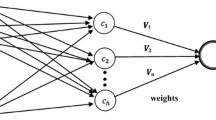Abstract
Fluctuation mining is one of the greatest challenging tasks in the field of finance market. The main contribution of this research was to propose a multiple dimensioned model for financial market fluctuation mining. In this approach, the original financial time series is broken down into different information by the wavelet filtering technique, and then, all this information is handled through radial basis function networks due to its universal approximation abilities and more robust than the ordinary networks. An experimental analysis is conducted with the proposed model using stock index future time series, revealing consistent performance improvement of this kind of multidimensional approach.





Similar content being viewed by others
References
Yu L, Chen HH, Wang SY, Lai KK (2009) Evolving least squares support vector machines for stock market trend mining. IEEE Trans Evol Comput 13(1):87–102
Andersen TG, Bollerslev T (1998) Answering the skeptics: yes, standard volatility models do provide accurate forecasts. Int Econ Rev 39:885–905
Resta M (2009) Seize the (intra) day: features selection and rules extraction for tradings on high-frequency data. Neurocomputing 72:3413–3427
Chortareasa G, Jiangb Y, Nankervisc JC (2011) Forecasting exchange rate volatility using high-frequency data: is the euro different? Int J Forecast 27:1089–1107
Matías JM, Reboredo JC (2012) Forecasting performance of nonlinear models for intraday stock returns. J Forecast 31:172–188
Marcek D, Marcek M, Babel J (2009) Granular RBF NN approach and statistical methods applied to modelling and forecasting high frequency data. Int J Comput Int Syst 2(4):353–364
Martens M, Zein J (2004) Predicting financial volatility: high-frequency time-series forecasts vis-`a-vis implied volatility. J Futur Mark 24:1005–1028
Hol E, Koopman SJ (2002) Stock index volatility forecasting with high frequency data. Tinbergen Institute Discussion Paper No. 2002-068/4
Pong S, Shackleton M, Taylor SJ, Xu X (2004) Forecasting currency volatility: a comparison of implied volatilities and AR(FI)MA models. J Bank Financ 28(9):2541–2563
Jones B (2003) Is ARCH useful in high frequency foreign exchange applications? Research paper No. 24. Applied Finance Centre, Macquarie University
Xiao Y, Xiao J, Liu J, Wang S (2014) A multiscale modeling approach incorporating ARIMA and ANNs for financial market volatility forecasting. J Syst Sci Complex 27:225–236
Refenes AN, Azema-Barac M, Chen L, Karoussos SA (1993) Currency exchange rate prediction and neural network design strategies. Neural Comput Appl 1(1):46–58
Bahrammirzaee A (2010) A comparative survey of artificial intelligence applications in finance: artificial neural networks, expert system and hybrid intelligent systems. Neural Comput Appl 19(8):1165–1195
Xiao Y, Xiao J, Lu F, Wang S (2013) Ensemble ANNs-PSO-GA approach for day-ahead stock E-exchange prices forecasting. Int J Comput Int Sys 6(1):96–114
Hsu CM (2013) A hybrid procedure with feature selection for resolving stock/futures price forecasting problems. Neural Comput Appl 22(3–4):651–671
Xiao Y, Liu JJ, Hu Y, Wang Y, Lai KK, Wang S (2014) A neuro-fuzzy combination model based on singular spectrum analysis for air transport demand forecasting. J Air Transp Manag 39:1–11
Dhamija AK, Bhalla VK (2011) Exchange rate forecasting: comparison of various architectures of neural networks. Neural Comput Appl 20(3):355–363
Xiao Y, Xiao J, Wang S (2012) A hybrid model for time series forecasting. Hum Syst Manag 31:133–143
Chen AS, Leung MT (2004) Regression neural network for error correction in foreign exchange forecasting and trading. Comput Oper Res 31(7):1049–1068
Ni H, Yin HJ (2009) Exchange rate prediction using hybrid neural networks and trading indicators. Neurocomputing 72(13–15):2815–2823
Mallat S (1989) A theory for multiresolution signal decomposition: The wavelet representation. IEEE Trans Pattern Anal Mach Intell 11:674–693
Percival DB, Walden AT (2000) Wavelet methods for time series analysis. Cambridge University Press, Cambridge
Tsai CH, Chuang HT (2004) Deadzone compensation based on constrained RBF neural network. J Frankl Inst 341:361–374
Poggio T, Girosi F (1989) A theory of networks for approximation and learning. MIT, Cambridge
Ramsey JB (1999) The contribution of wavelets to the analysis of economic and financial data. Philos Trans R Soc Lond Ser A-Math Phys Eng Sci 357:2593–2606
Zhang GP (2003) Time series forecasting using a hybrid ARIMA and neural network model. Neurocomputing 50:159–175
Acknowledgments
This research is supported by the National Social Science Foundation of China under Grant No. 14BGL175, National Natural Science Foundation of China under Grant Nos. 71301160 and 71101100, and the Center for Forecasting Science of the Chinese Academy of Sciences. This paper was completed during the first author’s visit at Center for Transport Trade and Financial Studies, City University of Hong Kong. He is grateful to the center and the university for financial support for his visit.
Author information
Authors and Affiliations
Corresponding author
Rights and permissions
About this article
Cite this article
Xiao, Y., Liu, J.J., Wang, S. et al. Multiple dimensioned mining of financial fluctuation through radial basis function networks. Neural Comput & Applic 26, 363–371 (2015). https://doi.org/10.1007/s00521-014-1722-x
Received:
Accepted:
Published:
Issue Date:
DOI: https://doi.org/10.1007/s00521-014-1722-x




